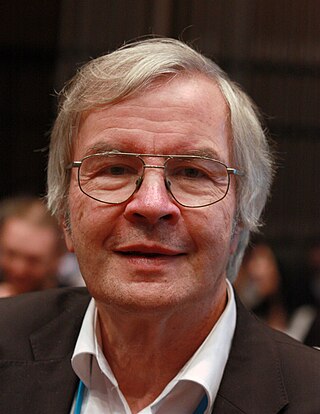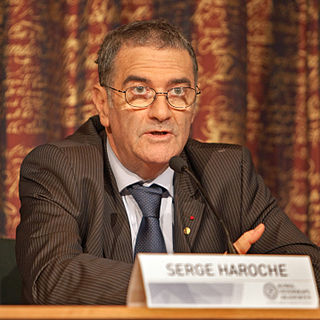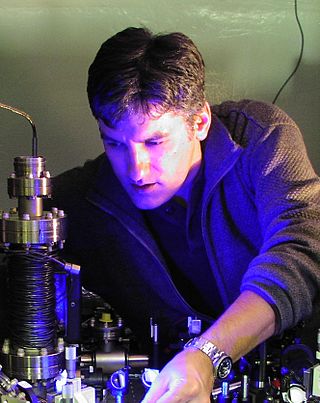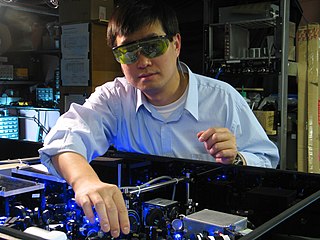Related Research Articles
Atomic, molecular, and optical physics (AMO) is the study of matter–matter and light–matter interactions, at the scale of one or a few atoms and energy scales around several electron volts. The three areas are closely interrelated. AMO theory includes classical, semi-classical and quantum treatments. Typically, the theory and applications of emission, absorption, scattering of electromagnetic radiation (light) from excited atoms and molecules, analysis of spectroscopy, generation of lasers and masers, and the optical properties of matter in general, fall into these categories.

Nicolaas Bloembergen was a Dutch-American physicist and Nobel laureate, recognized for his work in developing driving principles behind nonlinear optics for laser spectroscopy. During his career, he was a professor at Harvard University and later at the University of Arizona and at Leiden University in 1973.

Arthur Leonard Schawlow was an American physicist and co-inventor of the laser with Charles Townes. His central insight, which Townes overlooked, was the use of two mirrors as the resonant cavity to take maser action from microwaves to visible wavelengths. He shared the 1981 Nobel Prize in Physics with Nicolaas Bloembergen and Kai Siegbahn for his work using lasers to determine atomic energy levels with great precision.

William Daniel Phillips is an American physicist. He shared the Nobel Prize in Physics, in 1997, with Steven Chu and Claude Cohen-Tannoudji.

Ali Javan ; December 26, 1926 – September 12, 2016) was an Azerbaijani-American physicist and inventor. He was the first to propose the concept of the gas laser in 1959 at the Bell Telephone Laboratories. A successful prototype, constructed by him in collaboration with W. R. Bennett, Jr., and D. R. Herriott was demonstrated in 1960. His other contributions to science have been in the fields of quantum physics and spectroscopy.

Roy Jay Glauber was an American theoretical physicist. He was the Mallinckrodt Professor of Physics at Harvard University and Adjunct Professor of Optical Sciences at the University of Arizona. Born in New York City, he was awarded one half of the 2005 Nobel Prize in Physics "for his contribution to the quantum theory of optical coherence", with the other half shared by John L. Hall and Theodor W. Hänsch. In this work, published in 1963, he created a model for photodetection and explained the fundamental characteristics of different types of light, such as laser light and light from light bulbs. His theories are widely used in the field of quantum optics. In statistical physics he pioneered the study of the dynamics of first-order phase transitions, since he first defined and investigated the stochastic dynamics of an Ising model in a paper published in 1963. He served on the National Advisory Board of the Center for Arms Control and Non-Proliferation, the research arms of Council for a Livable World.

Theodor Wolfgang Hänsch ; born 30 October 1941) is a German physicist. He received one-third of the 2005 Nobel Prize in Physics for "contributions to the development of laser-based precision spectroscopy, including the optical frequency comb technique", sharing the prize with John L. Hall and Roy J. Glauber.
Margaret Mary Murnane NAS AAA&S is Distinguished Professor of Physics at the University of Colorado at Boulder, having moved there in 1999, with past positions at the University of Michigan and Washington State University. She is currently Director of the STROBE NSF Science and Technology Center, and is among the foremost active researchers in laser science and technology. Her interests and research contributions span topics including atomic, molecular, and optical physics, nanoscience, laser technology, materials and chemical dynamics, plasma physics, and imaging science. Her work has earned her multiple awards including the prestigious MacArthur Fellowship award in 2000, the Frederic Ives Medal/Quinn Prize in 2017, the highest award of The Optical Society, and the 2021 Benjamin Franklin Medal in Physics.

Serge Haroche is a French physicist who was awarded the 2012 Nobel Prize for Physics jointly with David J. Wineland for "ground-breaking experimental methods that enable measuring and manipulation of individual quantum systems", a study of the particle of light, the photon. This and his other works developed laser spectroscopy. Since 2001, Haroche is a professor at the Collège de France and holds the chair of quantum physics.

The Max-Planck-Institute of Quantum Optics is a part of the Max Planck Society which operates 87 research facilities in Germany.
Markus Greiner is a German physicist and Professor of Physics at Harvard University.

Robert Louis Byer is a physicist. He was president of the Optical Society of America in 1994 and of the American Physical Society in 2012.

David Jeffrey Wineland is an American Nobel-laureate physicist at the National Institute of Standards and Technology (NIST) physics laboratory. His work has included advances in optics, specifically laser-cooling trapped ions and using ions for quantum-computing operations. He was awarded the 2012 Nobel Prize in Physics, jointly with Serge Haroche, for "ground-breaking experimental methods that enable measuring and manipulation of individual quantum systems".
Immanuel Bloch is a German experimental physicist. His research is focused on the investigation of quantum many-body systems using ultracold atomic and molecular quantum gases. Bloch is known for his work on atoms in artificial crystals of light, optical lattices, especially the first realization of a quantum phase transition from a weakly interacting superfluid to a strongly interacting Mott insulating state of matter.

Philip H. Bucksbaum is an American atomic physicist, the Marguerite Blake Wilbur Professor in Natural Science in the Departments of Physics, Applied Physics, and Photon Science at Stanford University and the SLAC National Accelerator Laboratory. He also directs the Stanford PULSE Institute.

Christopher Roy Monroe is an American physicist and engineer in the areas of atomic, molecular, and optical physics and quantum information science, especially quantum computing. He directs one of the leading research and development efforts in ion trap quantum computing. Monroe is the Gilhuly Family Presidential Distinguished Professor of Electrical and Computer Engineering and Physics at Duke University and is College Park Professor of Physics at the University of Maryland and Fellow of the Joint Quantum Institute and Joint Center for Quantum Computer Science. He is also co-founder and chief scientist at IonQ, Inc.
Michael David Fayer is an American chemical physicist. He is the David Mulvane Ehrsam and Edward Curtis Franklin Professor of Chemistry at Stanford University.

Peter E. Toschek was a German experimental physicist who researched nuclear physics, quantum optics, and laser physics. He is known as a pioneer of laser spectroscopy and for the first demonstration of single trapped atoms (ions). He was a professor at Hamburg University.

Jun Ye is a Chinese-American physicist at JILA, National Institute of Standards and Technology, and the University of Colorado Boulder, working primarily in the field of atomic, molecular and optical physics.

Charles Vernon (Chuck) Shank is an American physicist, best known as the director of the Lawrence Berkeley National Laboratory from 1989 to 2004.
References
- ↑ "Celebrating Black in Physical Sciences Colloquium lecture series launches | UCI". ps.uci.edu. Retrieved 2023-03-17.
- 1 2 3 4 5 "Wendell Hill's Biography". The HistoryMakers. Retrieved 2023-03-17.
- 1 2 3 4 Hill, Wendell T. Resume of Wendell T. Hill. Box 1, folder 21. Ronald E. Mickens collection on African-American physicists, circa 1950-2008. Niels Bohr Library & Archives, American Institute of Physics. 3 April 2023. https://libserv.aip.org/ipac20/ipac.jsp?session=1C80N465R3370.1846&menu=search&aspect=power&npp=10&ipp=20&spp=20&profile=rev-all&ri=1&source=%7E%21horizon&index=.GW&term=Hill%2C+Wendell+T.&x=0&y=0&aspect=power
- 1 2 3 Hill, Wendell Talbot (1980). Intracavity Absorption Spectroscopy (Thesis). ProQuest 303065514.
- 1 2 3 "Atoms, Molecules and Light - Physics Serving Society - Wendell T. Hill, III". PSW Science. Retrieved 2023-03-17.
- 1 2 3 4 5 6 "Professor Wendell Hill '74 Colloquium - Precision Measurement of the Quantum Vacuum with Petawatt Lasers | UCI". ps.uci.edu. Retrieved 2023-03-17.
- ↑ Mickens, Ronald (1999). The African American Presence in Physics. Atlanta, Georgia: National Society of Black Physicists. p. 63. https://radar.auctr.edu/islandora/object/cau.ir%3A1999_mickens_ronald_e
- ↑ "New Members".